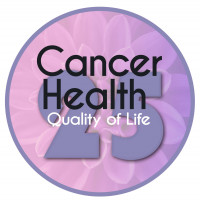The Cancer Health 25 is an annual list that honors individuals who have made a difference in the lives of people with cancer. This year’s theme is quality of life. To see the full list, click here.

Twenty-seven years ago, a clinical trial for an experimental cancer treatment saved Melvin Mann’s life. And he’s been paying it forward ever since, helping other people with cancer overcome barriers to getting the best clinical cancer care.
In 1995, at age 37, Melvin Mann, an Army major with a wife and 5 year-old daughter, was diagnosed with chronic myeloid leukemia (CML) after experiencing back pain for some time. Mann was informed that a bone marrow transplant could give him a chance to survive. Without it, he was told, he’d have only three years left to live. Mann, now 65, worried what his diagnosis would mean for his family.
After seeking a second opinion, Mann decided to look for a donor. None of Mann’s relatives were a marrow match, and national registries couldn’t locate a match for him either. The next step was to set up bone marrow drives.
Mann did media interviews and helped raise awareness about bone marrow donations while fighting to live. With the help of the national nonprofit Be The Match, Mann, along with family and friends, organized a bone marrow drive that attracted more than 10,000 people. He and his wife have continued to volunteer for the organization.
Unfortunately, the drives didn’t result in a match for him, although it helped others. But at one of the events, he met a leukemia survivor who encouraged him to visit the University of Texas MD Anderson Cancer Center, where he joined a clinical trial that saved his life.
In August 1998, MD Anderson received approval to test an experimental chemotherapy drug called STI571 on cancer patients. “That August, I became the second person at MD Anderson to take STI571, and I responded very well,” Mann wrote in 2014 for the MD Anderson website.
In January 1999, the Leukemia and Lymphoma Society (LLS) asked him to be a “patient hero” and have volunteers run a marathon in his honor. Instead, he decided to run the marathon himself. He knew that LLS had played a large role in funding the STI571 clinical trial.
So in June 1999, he ran the Anchorage Mayor’s Marathon in Alaska. In November1999, he completed the 111-mile El Tour de Tucson bike ride for the Leukemia and Lymphoma Society’s Team in Training.
In 2001, the Food and Drug Adminstration approved STI571 for use as Gleevec (imatinib). It was the first drug of its kind, paving the way for other targeted therapies to treat CML. “That little bitty pill turned out to be better than this massive operation, which is a miracle,” he told Cancer Horizons in 2021.
Mann still takes Gleevec; in fact, he is the world’s longest living patient on that drug, and he credits MD Anderson’s research with allowing him to see his daughter grow up to become a physician. Along the way, he has helped connect countless people to bone marrow matches and clinical trials. Between 2018 and 2020, Mann worked as LLS’s national community outreach coordinator to expand the organization’s pilot program Myeloma Link, which spreads blood cancer awareness to Black communities, from two cities to 13 cities nationwide.







Comments
Comments